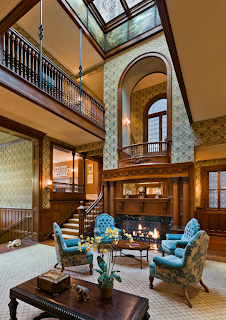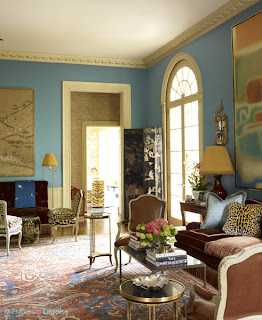Miles Redd, designer extrordinaire,
Danielle Rollins, hostess extraordinaire, and
Richard Lambertson, tastemaker and design director for Tiffany's, spoke about the synergy between design mediums. Moderated by CJ Carey of
NYC & G Magazine, we got a peek inside the minds of 3 very chic, stylish people. The discussion took a fortuitous turn when I realized that Danielle wrote the beautiful book
SOIRÉE,
and Miles Redd are very good friends. Miles, by the way, also has a book due out in a week or so. It is aptly named,
The Big Book of Chic, which he is, and everything he does, is! Their friendship was solidified when Miles designed the interiors of Danielle's home in Atlanta. Boxwood is a famous 1920 estate in Buckhead. I remembered that home, as I had seen it in Town and Country and was blown away by its beauty. I dogeared the pages to write about it at some future date. Well, that day has come. They both easily chatted about how they came together to design this classic home, each influencing the other.
Clearly, the house had beautiful bones. Miles respected that and added that certain je ne sais quoi that is signature Miles Redd.
As designers we ask ourselves, who is the client? How to they live? What are their are fantasies and how can we translate them into an interior of a home, or in the case of Robert Lambertson; a handbag?
While Miles came up with the extraordinary design ideas, it sounded like Danielle, with 3 kids and several dogs made sure function and practicality were also considered. They can co-exist!
Danielle told the story about when she got a call from Miles saying,"Let's tent the dining room." Danielle replied, "As long as we can laminate the walls to protect them from the kids and dogs."
The library is very similar to the famous lacquered jewel box that Albert Hadley created for Brooke Astor, replete with brass trim; an inspiration for everyone.
The ruffled curtains were inspired by an Oscar de la Renta ball gown. Miles works with Oscar on a fabric line for Lee Jofa. Everything is intertwined!
Everyone agreed that style is not about money, it's more of an attitude--the confidence to be adventurous, take risks, but stay true to who you are. It doesn't matter if you are creating and executing a theme for a party or respecting Tiffany's past while taking it into the future. Chic is Chic is Chic....
phs: Francesco Lagnese, first photo: Assouline, last ph:CLI







.jpg)














































